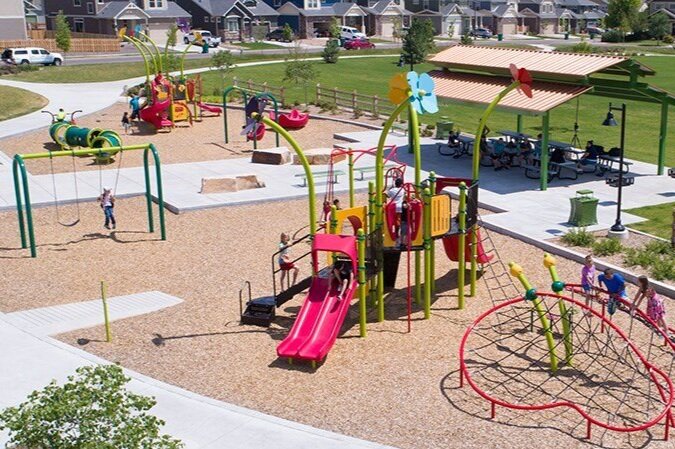Many adults today remember childhoods full of hot metal slides baking in the sun, sky-high monkey bars with rough concrete beneath them, and swings that soared above a seemingly endless expanse of worn grass. Today, you look around at playgrounds and see brightly colored plastic slides surrounded by sand, complex multi-level play structures with spongy surfaces waiting below, and zip lines with impact absorbing platforms on either side.
Photo Credit: Click Americana, Vintage and Retro Memories | 1900’s
Photo Credit: Landscape Structures | 2017
Seeing all of these cushioned corners and safety rails, the question lurks at the back of our minds, “Are we bubble wrapping kids?”
Now contrast that playful imagery of modern playgrounds with abrasive, injury-prone concrete surfaces that coat many splash pads and pool decks still today.
Consider the playground example: for decades playgrounds had no safety surfacing and as a result kids were injured often. Then wood chips, rubberized surfaces, sand, and other cushioned materials were introduced in an effort to promote play while mitigating injuries. The result was an environment that promotes play, reduces liability, and limits the number of serious play-related injuries.
Splash pads are essentially playgrounds with water, so why wouldn’t we treat them the same way?
When water is combined with concrete surfacing on splash pads, hydroplaning occurs and results in slip and fall accidents. These accidents typically involve concussions, road rash, and other major play-halting injuries due to the unsafe risks associated with concrete surfacing.
TYPES OF RISK
You may ask, “But isn’t it good for kids to learn how to handle risk and learn how to fall properly?”
We completely agree that learning how to fall is important, but injuries that halt play because of a concussion or broken limb are not acceptable. These injuries are avoidable, costly, and can have lasting negative implications. Simply put, there’s bad risk and there’s good risk.
Bad risk is also known as a hazard and involves things that can cause harm to an individual such as sharp edges, hot surfaces, and hard impacts (1). This kind of risk does not allow for children to grow and learn positively - it often causes aversion to the source and triggers fear responses. Young toddlers are inherently clumsy and do not yet have full motor control of their limbs. When this clumsiness is paired with their inability to reason and determine dangerous situations, injuries can feel more terrifying and out-of-control. Often, when a child is injured they tend to associate the injury with their surroundings instead of the specific thing that hurt them which causes aversion to an environment (2).
Good risk is often associated with what we call ‘risky play.’ Risky play can appear in many different forms based on age, motor skills, and ability. Some types of risky play include (3):
Play with High Speed
Rough and Tumble Play
Play Near Dangerous Elements (Water)
Splash pads that feature concrete surfacing inhibit children from engaging in some of these types of risky play. When a surface is slip-resistant and cushioned instead, the opportunities for engaging a greater range of activities and types of risky play are more available. Children are able to run, hop, crawl, cartwheel, tumble, and move freely around a zone of water play in more ways than if safety surfacing wasn’t included on the splash pad.
Like we said, kids are inherently clumsy and they will trip over their own feet and fall. However, when they do fall, our mission at Life Floor is to ensure they get right back up and continue imagining, learning, and creating their own world of risky play instead of getting injured and ending their day of family fun.
NSF International agrees that splash pads need safety surfacing. In 2019 they passed NSF/ANSI/CAN Standard 50:26 outlining criteria for safety surfacing products which include slip-resistance and cushioning. They recognize that similar safety parameters are needed in comparison to dry playgrounds.
We don’t want kids to feel averse to aquatic facilities especially as they're first introduced to aquatics and water; we want to enable them to positively play, explore, and learn through these new experiences.
SO TO ANSWER THE BURNING QUESTION:
No, we aren’t bubble wrapping kids with safety surfacing. We’re enabling risky play and we’re helping them avoid unnecessary hazards until they’re old enough to understand them.
Let’s let them explore, run, jump, and play freely instead of telling them to walk slow and mind the slippery concrete in an effort to try and stay safe.
If you would like to continue the conversation, please email us at solutions@lifefloor.com to share your ideas.
Sources:
1. Ken Kutska | Executive Director of the International Playground Safety Institute | Past president of NRPA | Chair of the ASTM F15.29 Subcommittee for performance requirements for public play equipment.
2. https://www.psychologytoday.com/us/blog/think-act-be/201609/21-common-reactions-trauma
3. Source: Sandsetter, Ellen Beate Hansen (2009): "Characteristics of Risky Play". Journal of Adventure Education & Outdoor Learning. 9:1, 3-21.





